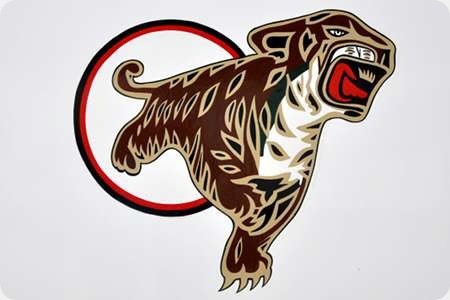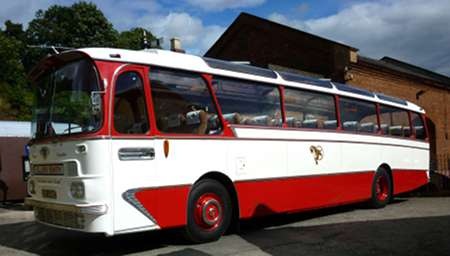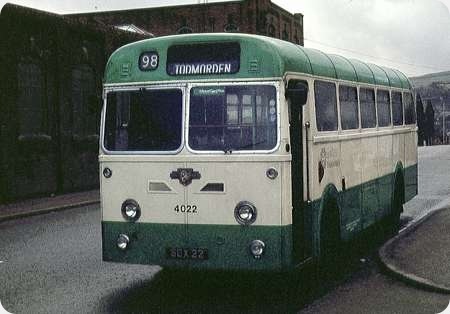Ellen Smith Tours – Leyland Leopard – CDK 448C
Ellen Smith’s Tours (Rochdale)
1965
Leyland Leopard PSU3/3R
Harrington C49F
CDK 448C is quite clearly a 1965 Leyland Leopard with Harrington body, as seen in the first view. She is of the PSU3/3R variety although some sources have her as a PSU3/3RT, while the seating is of the C49F layout. She is seen at the Harrington Event at Amberley on 3 June 2012. There has been some discussion in these pages about the resemblance of the leaping cat badge seen in the second view to the Royal Tiger badge on the front of Leyland’s product. Indeed, the company history, as set out by Eric Ogden, comments thus:
"The striking Leaping Tiger crest applied to the sides of the coaches, first in a triangle and then in a circle, appeared in the early 1930s on the Leyland Tigers. It is said that the first hand-painted image was copied from a cigarette card. This skilful freehand painting was carried out by Jack Mills who was trained as a professional painter. The design was used by Leyland as the badge for the Royal Tiger coach from 1949. The same design was used as the sign for the Royal Tiger pub in Leyland."
The device faces forward on both sides, so Leyland must have used that on the offside of the Ellen Smith vehicles.
Photograph and Copy contributed by Pete Davies
10/01/16 – 10:54
Thanks to Pete Davies for his posting. I had wondered about the side logo since taking a few shots of this splendid vehicle at the Bus Meet-Bewdley 2013. I would be very interested in future posts relating to its history.
Nigel Edwards
11/01/16 – 06:51
What a great coach of the era, they were far better built and did not rattle in later life.
Mike
11/01/16 – 09:24
Thank you, Nigel and Mike. I’ve wondered at intervals over the years which were the better-built vehicles, Duple, Harrington or Plaxton. Of course, I know that will provoke some comment on here!!!!!
Pete Davies
11/01/16 – 13:39
There were a couple of glimpses of an Ellen Smith coach at the end of Endeavour last night. Is this the only one in livery? And would it have worked in the Oxford area in period?
John Lomas
11/01/16 – 13:40
This lovely coach appeared towards the end of an episode of ‘Endeavour’ on ITV Sunday 10 January 2015.
Note that in the photograph the coach carries an ‘On hire to Yelloway’ window label. I have seen various photographs of the coach with this addition. However, it is perhaps the strangest item in respect of 1960s/1970s authenticity one can have on an Ellen Smith’s coach. Both Ellen Smith and Yelloway heralded from the Lancashire town of Rochdale and were great competitors. Hubert Allen and Harry Smith got together to discuss matters of mutual benefit or business interest but that was the extent of it. During my time at Yelloway in the late 1960s/early 1970s there was never any inter-hiring as far as I can recall. They did, in later years, participate in a joint service to Morecambe.
I recall on a number of occasions when I worked at Yelloway being sent over to Newgate to furtively spy on Ellen’s excursion departures see if their loadings looked better than ours. What was a little irritating to me as I did my absolute best at playing an undercover spy was that most of the passengers recognised me and gave me a wave as they went by!
David Slater
11/01/16 – 13:40
Pete. You have to factor in chassis as well. Flexing chassis can distort even the best built body. I have a Harrington on a PS1 which while sumptuous is quite a rattlebox yet my friend has same body on a PS2 and it is rock solid
Roger Burdett
11/01/16 – 16:03
Even Mrs B noticed the coach on the TV last night. Whilst an excursion may have taken one of Smith’s coaches into Morse territory, the use of the coach in the context of the programme’s plot did not fit.
A shame really as the previous week the use of two preserved Oxford double deckers was very much in context.
Phil Blinkhorn
11/01/16 – 16:05
You noticed, David! I wondered who would be first. I thought it a bit of an oddity when I saw the sticker. I can’t tell from Nigel’s view whether it appears there or not.
Interesting comment, Roger! I’d have thought there might be a difference between, say, AEC and Guy affecting the way the body moved or didn’t, but I wouldn’t have expected it between models from the same line. Ah well, We live and learn!
Pete Davies
11/01/16 – 16:06
For me Pete, all through my driving days I aspired to one day having charge of a Harrington, be it AEC or Leyland no matter! It never happened . .
I agree with Roger, the rattles depend a great deal on Chassis, a Duple on a R226 SO different to an AEC or Leyland. My personal pet hate was a Yeates – always seemed to leak around the myriad rubber window seals.
Nigel Edwards
12/01/16 – 05:51
I doubt that Ellen Smith vehicles would have visited the Oxford area on any regular basis as most of their operations were in the north west. They did a good deal of business in the winter months running supporter’s coaches for the away games of Rochdale Hornets. They also provided the team coach, complete with distinctive headboard for many years. Many’s the trip I made across Lancashire and Yorkshire to far flung destinations such as Dewsbury, Batley, Leigh, Widnes and numerous other rugby league playing towns. It was usually on one of the earlier Cavalier bodied 36ft Leopards. The fleet was always immaculately turned out and the fares were always very reasonable. A truly quality operation.
Philip Halstead
12/01/16 – 08:22
I made a day trip with Ellen Smith from Rochdale to the 1974 Commercial Motor Show at Earl’s Court. The transport was a Plaxton Panorama Elite-bodied Leyland Leopard. The main thing I remember is the rather low back seats which were a bit of a surprise for such a long trip, although they were more than bus seats.
David Beilby
20/01/16 – 09:21
The latest episode of Endevour had a Burlingham Seagull coach in a red and blue livery dropping a character off in central Oxford. Sadly it was too far away to see what it was.
Chris Hough
20/01/16 – 17:13
The Seagull was the preserved Whittles of Kidderminster Seagull on a Leyland Tiger Cub chassis owned by Bernard Rodgers of Bewdley. His standard of presentation is always top class and it could be argued looked too good for the role of delivering passengers back from holidays.
Roger Burdett
Quick links to the - Comments Page - Contact Page - Home Page





